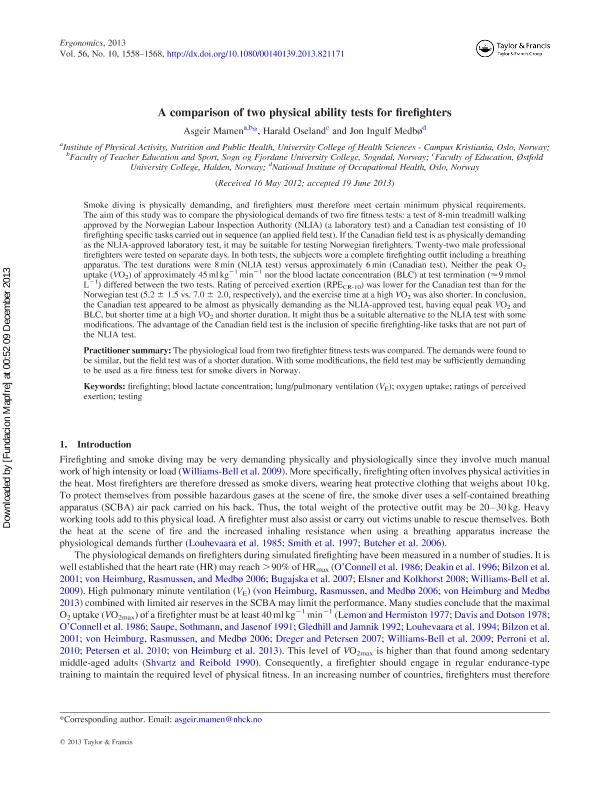A Comparison of two physical ability tests for firefighters

Contenido multimedia no disponible por derechos de autor o por acceso restringido. Contacte con la institución para más información.
| Tag | 1 | 2 | Valor |
|---|---|---|---|
| LDR | 00000cab a2200000 4500 | ||
| 001 | MAP20130040738 | ||
| 003 | MAP | ||
| 005 | 20131209105116.0 | ||
| 008 | 131209e20131007esp|||p |0|||b|spa d | ||
| 040 | $aMAP$bspa$dMAP | ||
| 084 | $a875 | ||
| 100 | 1 | $0MAPA20130017594$aMamen, Asgeir | |
| 245 | 1 | 2 | $aA Comparison of two physical ability tests for firefighters$cAsgeir Mamen, Harald Oseland, Jon Ingulf Medbø |
| 520 | $aSmoke diving is physically demanding, and firefighters must therefore meet certain minimum physical requirements. The aim of this study was to compare the physiological demands of two fire fitness tests: a test of 8-min treadmill walking approved by the Norwegian Labour Inspection Authority (NLIA) (a laboratory test) and a Canadian test consisting of 10 firefighting specific tasks carried out in sequence (an applied field test). If the Canadian field test is as physically demanding as the NLIA-approved laboratory test, it may be suitable for testing Norwegian firefighters. Twenty-two male professional firefighters were tested on separate days. In both tests, the subjects wore a complete firefighting outfit including a breathing apparatus. The test durations were 8 min (NLIA test) versus approximately 6 min (Canadian test). Neither the peak O2 uptake (VO2) of approximately 45 ml kg - 1 min - 1 nor the blood lactate concentration (BLC) at test termination ( 9 mmol L - 1) differed between the two tests. Rating of perceived exertion (RPECR-10) was lower for the Canadian test than for the Norwegian test (5.2 ± 1.5 vs. 7.0 ± 2.0, respectively), and the exercise time at a high VO2 was also shorter. In conclusion, the Canadian test appeared to be almost as physically demanding as the NLIA-approved test, having equal peak VO2 and BLC, but shorter time at a high VO2 and shorter duration. It might thus be a suitable alternative to the NLIA test with some modifications. The advantage of the Canadian field test is the inclusion of specific firefighting-like tasks that are not part of the NLIA test. | ||
| 773 | 0 | $wMAP20100019818$tErgonomics : the international journal of research and practice in human factors and ergonomics$dOxon [United Kingdom] : Taylor & Francis, 2010-$x0014-0139$g07/10/2013 Volumen 56 Número 10 - octubre 2013 |

